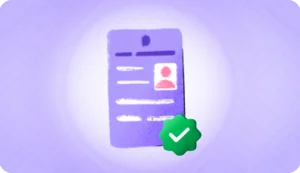We live in a world where catfishing isn’t just for online dating and phishing goes beyond the waters. Businesses are facing a crucial challenge—knowing who’s who in the virtual crowd.
The cost of identity fraud isn’t just measured in dollars but also in the trust that businesses strive so hard to build.
Identity proofing services verify a person’s identity, eliminate fraud risk, and safeguard businesses and individuals alike. In this blog, we’ll take a deep dive into understanding identity proofing and how you can implement it for your business.
What is Identity Proofing?
Identity proofing verifies that a person’s claimed identity matches their actual identity.
Verifying identities is a critical step in establishing trust and security during online banking, transactions, onboarding customers, or even bank account verification. It serves as a gatekeeper, ensuring that only legitimate users gain access to your services and sensitive data.
Identity Proofing Process: How Does Identity Proofing Work?
The National Institute of Standards and Technology (NIST)’s Digital Identity Guidelines assert that there are three vital steps in identity proofing.
1. Resolution
This step establishes the individual as a unique identity. It starts with collecting Personally Identifiable Information (PII) details such as name, age, address, date of birth, email, bank account details, and phone number, along with two forms of identification, like a driver’s license and passport.
2. Validation
This step verifies if the claimed identity of the individual matches their records. This includes closely examining the images of the provided IDs (such as driver’s licenses) to make sure they’re real, checking QR codes, confirming that the ID numbers follow the right format, and verifying other records like a credit report.
3. Verification:
This third and final step is an added layer of identity verification methods. It includes facial recognition, biometric verification, and two-factor authentication.
Top-notch identity proofing services effortlessly tackle the task at hand—collecting user info, cross-referencing claimed identities with the real deal, and greenlighting legitimate individuals—all in a few minutes. No need for human intervention.
Let’s take a closer look at the added layers of the verification process mentioned above:
Facial Recognition
Facial recognition analyzes facial features to verify an individual’s identity. This method has gained popularity in various sectors due to its convenience and efficiency. Facial recognition compares the unique features of a person’s face with the ID document with a high level of accuracy.
Worth mentioning that HyperVerge’s facial recognition algorithms rank in the top 10 globally by NIST!
Two-factor or Multi-factor Authentication
Two-factor authentication (2FA) adds built-in layers of security by requiring users to provide two forms of identification before granting access. This involves something the user knows (like a password or security questions) and something the user has (like a verification code sent to their mobile device).
Biometric Authentication
Biometric authentication leverages unique physical characteristics, such as fingerprints, voice recognition, or iris scans to verify an individual’s identity.
Why is Identity Proofing Important?
Cybercriminals are evolving and developing sophisticated methods of committing digital fraud as we speak. That’s why identity proofing matters—it’s a robust defense mechanism.
Identity proofing is also important for safeguarding an individual’s sensitive information. This helps in mitigating the risk of identity theft and provides one with peace of mind when engaging in online transactions.
Needless to say, identity proofing also enables businesses to comply with regulatory requirements and industry standards. Data protection laws are becoming more stringent every day. Implementing robust identity proofing measures ensures compliance and avoids hefty penalties.
How Do Different Industries Deploy Identity Proofing?
Many industries, such as finance, healthcare, and government, have strict regulations in place to protect sensitive data and ensure the privacy of individuals.
In the financial realm, financial institutions comply with stringent measures like Know Your Customer (KYC) and Anti-Money Laundering (AML) protocols.
Industry-specific compliance regulations such as the Health Insurance Portability and Accountability Act (HIPAA) set the stage for safeguarding patient data and businesses — further underscoring the importance of identity proofing.
Challenges of Identity Proofing
The identity proofing process is not without its challenges. Let’s explore some of these challenges (and their solutions).
Dealing with False Positives and Negatives
One of the primary challenges faced in identity proofing is the occurrence of false positives and false negatives. False positives occur when an identity is wrongly classified as fraudulent, leading to inconvenience for the individual. Imagine being denied access to essential services or experiencing delays in critical processes due to a mistaken identity match. This can be not only frustrating but also detrimental to one’s daily life.
On the other hand, false negatives refer to cases where fraudulent identities go undetected, potentially causing significant harm. Criminals and fraudsters are constantly finding new ways to deceive identity proofing systems, making it challenging for organizations to stay one step ahead. The consequences of undetected fraudulent identities can range from financial losses to reputational damage for both individuals and organizations.
Striking a balance between accuracy and convenience is crucial in mitigating these challenges. Identity proofing systems need to be robust enough to detect and prevent fraudulent activities while minimizing false positives and negatives. This requires a combination of advanced technologies, intelligent AI algorithms, and continuous monitoring to adapt to evolving threats.
Balancing User Convenience and Security
Identity proofing processes must strike a delicate balance between user convenience and security. Overly complex or time-consuming verification processes will frustrate users and deter their engagement with you.
Imagine having to go through a lengthy and complicated identity verification process every time you want to access a digital service or make an online purchase. This can be not only time-consuming but also discouraging for users, leading to a poor user experience and potential loss of business for organizations.
Organizations need to find the right balance to ensure both security and a smooth user experience.
How to Implement Identity Proofing Solutions?
1. Assess Your Needs: Before diving into the world of identity proofing solutions, take a comprehensive look at your organization’s specific requirements. Identify the touchpoints where identity verification is crucial and understand the level of security needed.
2. Choose the Right Technology: With a plethora of technologies available, from biometrics to document verification, select the ID proofing service that is scalable and aligns with your goals. Consider factors such as user experience, scalability, and integration capabilities to ensure seamless implementation.
3. Regularly Update and Adapt: The landscape of identity verification is dynamic. Regularly update your systems to stay ahead of evolving security challenges. Additionally, be ready to adapt to emerging technologies and industry best practices to maintain a robust identity proofing framework.
Read more: Complete Guide to Secure User Onboarding with Digital Identity Verification
Parting Words
In a world where digital interactions are the norm, implementing robust identity proofing solutions is no longer a choice but a necessity. Whether you operate in finance, healthcare, or any other industry, the ability to authenticate identities accurately is paramount. By adopting a thoughtful approach, choosing the right technologies, and keeping your team well-informed, you’re not just securing sensitive information but also building a foundation of trust with your users.
HyperVerge ONE, our cutting-edge platform is reshaping the landscape of identity verification. With HyperVerge, you get:
- World’s best facial recognition algorithm
- Accurate and seamless KYC and AML solutions
- Deep insight into customer drop-offs
- No-code verification workflows to onboard customers across 195+ countries
Ready to start? Sign up here.
FAQs
Q1: Why is identity proofing important for businesses?
Identity proofing is crucial for businesses to mitigate the risks associated with fraud, unauthorized access, and data breaches. It not only protects businesses from identity fraud but also enhances customer trust and regulatory compliance.
Q2: What technologies are commonly used in identity proofing?
Biometrics (fingerprint, facial recognition), document verification, and multi-factor authentication are commonly used technologies in identity proofing. The choice depends on the specific needs and preferences of the business.
Q3: How often should identity proofing systems be updated?
Identity proofing systems should be regularly updated to adapt to emerging threats and technological advancements. A proactive approach ensures that your security measures stay effective in the ever-evolving landscape.




